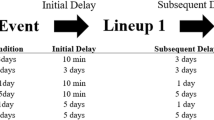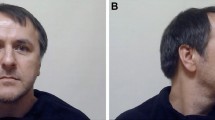Abstract
This research was designed to learn if children's relationships with interviewers might influence the accuracy of their eyewitness memory and their ability to make identifications from lineups. In two experiments, kindergarten children (5-year-olds) viewed a slide show depicting a minor theft. Children were then interviewed by either their own parent or an unfamiliar experimenter with either a target present or target absent simultaneous photographic lineup. When lineups were presented by parents, children were less accurate, changed their identifications more frequently, and were more likely to acquiesce with a suggestion about an alternative identification. Children showed poorer recall of the event when interviewed by their parent in an unstructured interview (Experiment 1); however, no differences were observed when parents and experimenters followed the same script (Experiment 2). Overall, the results indicate that interviewers can influence the accuracy and consistency of children's eyewitness identifications.
Similar content being viewed by others
References
Asendorpf, J. B. (1990). Development of inhibition during childhood: Evidence for situational specificity and a two-factor model.Developmental Psychology, 26, 721–730.
Baker-Ward, L., Burgwyn, E. O., Ornstein, P. A., & Gordon, B. N. (1995, April).Children's reports of a minor medical emergency procedure. Paper presented at the biennial meeting of the Society for Research in Child Development, Indianapolis IN.
Batterman-Faunce, J. M., & Goodman, G. S. (1993). Effects of context on the accuracy and suggestibility of children, witnesses. In G. S. Goodman & B. L. Bottoms (eds.),Child victims, child witnesses (pp. 301–330). New York: Guilford Press.
Beal, C. R., Schmitt, K., & Dekle, D. J. (1995). Eyewitness identification of children: Effects of absolute judgments, nonverbal response options, and event encoding.Law and Human Behavior, 19, 197–216.
Bottoms, B., Goodman, G., Schwartz-Kenney, B., Sachsenmaier, T., & Thomas, S. (1990, March).Keeping secrets: Implications for children's testimony. Paper presented at the biennial meeting of the American Psychology/Law Society, Williamsburg, VA.
Bussey, K., Lee, K., & Grimbeek, E. J. (1993). Lies and secrets: Implications for children's reporting of sexual abuse. In G.S. Goodman & B. L. Bottoms (Eds.),Child victims, child witnesses (pp. 147–168). New York: Guilford Press.
Ceci, S. J. (1995, March). Discussant's comments. In D. P. Peters (Chair),Children as witnesses: New research, new issues. Symposium conducted at the biennial meeting of the Society for Research in Child Development, Indianapolis.
Ceci, S. J., & Bruck, M. (1993). Suggestibility of the child witness: A historical review and synthesis.Psychological Bulletin, 113, 403–439.
Ceci, S. J., Ross, D. F., & Toglia, M. P. (1989).Perspectives on children's testimony. New York Springer Verlag.
Ceci, S. J., Ross, D. F., & Toglia, M. P. (1987). Suggestibility of children's memory: Psycholegal implications.Journal of Experimental Psychology: General, 116, 38–49.
Ceci, S. J., Toglia, M. P., & Ross, D. F. (1987).Children's eyewitness memory. New York: Springer Verlag.
Cole, C. B., & Loftus, E. F. (1987). The memory of children. In S. J. Ceci, M. P. Toglia, & D. F. Ross (Eds.),Children's eyewitness memory (pp. 178–208). New York: Springer-Verlag.
Dale, P. S., Loftus, E. F., & Rathbun, L. (1978). The influence of the form of the question on the eyewitness testimony of preschool children.Journal of Psycholinguistic Research, 7, 269–277.
Davies, G., Stevenson-Robb, Y., & Flin, R. (1988). Tales out of school: Children's memory for an unexpected event. In M. M. Gruneberg, P. E. Morris, & R. N. Sykes (Eds.),Practical aspects of memory: Current research and issues (Vol. 1, pp. 122–127). Chichester, England: Wiley.
Dekle, D. J., Beal, C. R., Elliott, R., & Huneycutt, D. (1995). Children as witnesses: A comparison of lineup versus showup identification methods.Applied Cognitive Psychology, 9, 354–366.
Doris, J. (1991).The suggestibility of children's recollections. Washington, DC: American Psychogical Association.
Evans, M. A. (1987). Discourse characteristics of reticent children.Applied Psycholinguistics, 8, 171–184.
Evans, M. A., & Bienert, H. (1992). Control and paradox in teacher conversationswith shy children.Canadian Journal of Behavioural Science, 24, 502–516.
Fivush, R., Hamond, N. R., Singer, N., & Wolf, A. (1991). Content and consistency in young children's autobiographical recall.Discourse Processes, 14, 373–388.
Geiselman, R. E., Saywitz, K. J., & Bornstein, G. K. (1993). Effects of cognitive questioning techniques on children's recall performance. In G. S. Goodman & B. L. Bottoms (Eds.),Child victims, child witnesses (pp. 71–93). New York: Guilford Press.
Goodman, G. S., & Bottoms, B. L. (1993).Child victims, child witnesses (pp. 117–146). New York: Guilford Press.
Goodman, G. S., Bottoms, B. L., Schwartz-Kenney, B., & Rudy, L. (1991). Children's testimony about a stressful life event: Improving children's reports.Journal of Narrative and Life History, 7, 69–99.
Goodman, G. S., & Reed, R. S. (1986). Age differences in eyewitness testimony.Law and Human Behavior, 10, 317–332.
Goodman, G. S., Rudy, L., Bottoms, B. L., & Aman, C. (1990). Children's concerns and memory: Issues of ecological validity in the study of children's eyewitness testimony. In R. Fivush & J. A. Hudson (Eds),Knowing and remembering in young children (pp. 249–284). Cambridge: Cambridge University Press.
Goodman, G. S., Sharma, A., Golden, M., & Thomas, S. (1991, April).the effects of mothers' and strangers' interviews on children's reporting of real life events. Paper presented at the biennial meeting of the Society for Research in Child Development, Seattle WA.
Goodman, G. S., Taub, E. P., Jones, D. P. H., England, P., Port, L. K., Rudy, L., & Prado, L. (1992).Testifying in criminal court. Monographs of the Society for Research in Child Development, 57(5, Serial No. 229).
Gross, J., Butler, S., & Hayne, H. (1995, March).Eyewitness memory in children: Factors influencing recognition and recall. Paper presented at the biennial meeting of the Society for Research in Child Development, Indianapolis IN.
Honts, C. R., Devitt, M. K., Tye, M. J. C., Peters, D. P., & Vondergeest, L. (1995, March).Credibility assessment with children. Paper presented at the biennial meeting of the Society for Research in Child Development, Indianapolis.
Horowitz, S. W., & Mendelsohn, R. J. (1994, July).Assessing verbal ability in child witnesses. Paper presented at the annual meeting of the American Psychological Society, Washington DC.
Menig-Peterson, C. L. (1975). The modification of communicative behavior in preschool-aged children as a function of the listener's perspective.Child Development, 46, 1015–1018.
Merritt, K. A., Ornstein, P. A., & Spicker, B. (1994). Children's memory for a salient medical procedure: Implications for testimony.Pediatrics, 94, 17–23.
Moston, S. (1987). The suggestibility of children in interview studies.Child Language, 7, 67–78.
Parker, J. F., Bahrick, L., Lundy, B., Fivush, R., & Levitt, M. (1994, August).The effects of stress on memory for a natural disaster. Paper presented at the Third Practical Aspects of Memory Conference, College Park MD.
Parker, J. F., & Carranza, L. E. (1989). Eyewitness testimony of children in target-present and target-absent lineups.Law and Human Behavior, 13, 133–149.
Parker, J. F., Haverfield, E., & Baker-Thomas, S. (1986). Eyewitness testimony of children.Journal of Applied Social Issues, 16, 287–302.
Parker, J. F., & Ryan, V. (1993). An attempt to reduce guessing behavior in children's and adults' eyewitness identifications.Law and Human Behavior, 17, 11–26.
Perry, N. W., & Wrightman, L. S. (1991).The child witness: Legal issues and dilemmas. Newbury Park, CA: Sage.
Peters, D. P. (1994, August).Stress, emotional arousal, and the child witness. Paper presented at the Third Practical Aspects of Memory Conference, College Park, MD.
Peters, D. P. (1991). The influence of stress and arousal on the child witness. In: J. Doris (Ed.),The suggestibility of children's recollections (pp. 60–76). Washington, DC: American Psychological Association.
Pettit, F., Fegan, M., & Howie, P. (1990, September).Interviewer effects on children's testimony. Paper presented at the International Congress on Child Abuse and Neglect, Hamburg, Germany.
Pillemer, D. B. (1992). Preschool children's memory of personal circumstances: The fire alarm study. In E. Winograd & U. Neisser (Eds.),Affect and accuracy in recall: Studies of “flashbulb” memories (pp. 121–137). Cambridge: Cambridge University Press.
Poole, D. A., & White, L. T. (1995). Tell me again and again: Stability and change in the repeated testimonies of children and adults. In M. S. Zaragoza, J.R. Graham, G. C. N. Hall, R. Hirschman, & Y.-S. Ben-Porath (Eds.),Memory and testimony in the child witness (pp. 24–43). Thousand Oaks CA: Sage.
Poole, D. A., & White, L. T. (1993). Two years later: Effects of question repetition and retention interval on the eyewitness testimony of children and adults.Developmental Psychology, 29, 844–853.
Poole, D., & White, L. T. (1991). Effects of question repetition on the eyewitness testimony of children and adults.Developmental Psychology, 27, 975–986.
Raskin, D. C., & Yuille, J. C. (1989). Problems in evaluating interviews of children in sexual abuse cases. In S. J. Ceci, D. F. Ross, & M. P. Toglia (Eds.),Children's eyewitness memory (pp. 184–207). New York: Springer Verlag.
Reznick, J. S., Kagan, J., Snidman, N., Gersten, M., Baak, K., & Rosenberg, A. (1986). Inhibited and uninhibited children: A followup study.Child Development, 57, 660–680.
Saywitz, K. J., Geiselman, R. E., & Bornstein, G. K. (1992). Effects of cognitive interviewing and practice on children's recall performance.Journal of Applied Psychology, 77, 744–756.
Siegal, M. (1991).Knowing children: Experiments in conversation and cognition. London: Lawrence Erlbaum.
Sonnenschein, S. (1988). The development of referential communication: Speaking to different listeners.Child Development. 59, 694–702.
Tate, C. S., Warren, A. R., & Hess, T. M. (1992). Adults' liability for children's “lie-ability”: Can adults coach children to lie successfully? In S. J. CEci, M. D. Leichtman, & M. Putnick (Eds.),Cognitive and social factors in early deception (pp. 69–87). Hillsdale, NJ: Erlbaum.
Tobey, A. E., & Goodman, G. S. (1992). Children's eyewitness memory: Effects of participation and forensic contex.Child Abuse and Neglect,16, 779–796.
Toglia, M. P., Ross, D. F., Ceci, S. J., & Hembrooke, H. (1992). The suggestibility of children's memory: A social-psychological and cognitive interpretation. In M. L. Howe, C. J. Brainerd, & V. F. Reyna (Eds.),Development of long term retention (pp. 217–241). New York: Springer Verlag.
Underwager, R., & Wakefield, H. (1990).The real world of child interrogations. Springfield, IL: Charles C. Thomas.
Warren, A., Hulse-Trotter, K., & Tubbs, E. C. (1991). Inducing resistance to suggestibility in children.Law and Human Behavior, 15, 273–285.
Wells, G. L. (1993). What do we know about eyewitness identification?American Psychologist, 48, 553–571.
Wells, G. L., Leippe, M. H., & Ostrom, T. M. (1979). Guidelines for empirically assessing the fairness of a lineup.Law and Human Behavior, 3, 285–293.
Yarmey, A. D. (1988). Streetroofing and bystanders' memory for a child abduction. In M. M. Gruneberg, P. E. Morris, & R. N. Sykes (Eds.),Practical aspects of memory: Current research and issues (Vol. 1, pp. 112–116). Chichester England: Wiley.
Author information
Authors and Affiliations
Corresponding author
About this article
Cite this article
Ricci, C.M., Beal, C.R. & Dekle, D.J. The effect of parent versus unfamiliar interviewers on children's eyewitness memory and identification accuracy. Law Hum Behav 20, 483–500 (1996). https://doi.org/10.1007/BF01499037
Issue Date:
DOI: https://doi.org/10.1007/BF01499037




